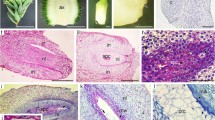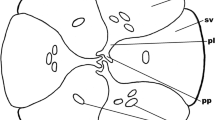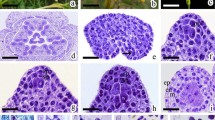Abstract
Embryological features ofGlaucidium palmatum are as follows: the ovule is anatropous and bitegmic; the archesporium is hypodermal and multicelled, consisting of about 10 to 15 cells; all the archesporial, cells develop directly into megaspore mother cells, only three or four of which, however, generally complete meiotic divisions; before and during meiosis, dermal cells of the nucellar apical part undergo successive periclinal divisions forming a thick nucellar cap of as many as 20 cell-layers; embryo sac formation is of the Polygonum type; multiple embryo sacs occur frequently; antipodal cells are small in size and ephemeral or persistent; the inner integument is 3 to 5 cell-layers thick, and the outer integument 7 to 13 cell-layers thick; the outer integument is vascularized; a micropyle is formed by the inner integument alone; the endosperm is of the Nuclear type; embryogeny is of a type similar to the Onagrad type.
In light of evidence from embryology and other sources it seems that there is ample reason for recognizing the family Glaucidiaceae which is distinct from the Ranunculaceae and its related families. Several common embryological features suggest an affinity between the Glaucidiaceae and the Paeoniaceae.
Similar content being viewed by others
References
Bouman, F. andJ.I.M. Calis. 1977. Integumentary shifting—a third way to unitegmy. Ber. Deutsch. Bot. Ges.90: 15–28.
Buchheim, G. 1964. Reihe Ranunculales.In: H. Melchior, ed., A. Engler's Syllabus der Pflanzenfamilien, 12 ed2: 131–147. Gebrüder Borntraeger, Berlin.
Cave, M.S., H.J. Arnott andS.A. Cook. 1961. Embryogeny in the Californian paeonies with reference to their taxonomic position. Amer. J. Bot.48: 397–404.
Crété, P. 1964. L'embryogénie et son rôle dans les essais de classification phylogénétique. Phytomorphology14: 70–78.
Cronquist, A. 1968. The Evolution and Classification of Flowering Plants. Houghton Mifflin, Boston.
Dahlgren, R. 1975. A system of classification of the angiosperms to be used to demonstrate the distribution of characters. Bot. Notiser128: 119–147.
Davis, G.L. 1966. Systematic Embryology of the Angiosperms. John Wiley and Sons, New York.
Eames, A.J. 1961. Morphology of the Angiosperms. McGraw-Hill, New York.
Engler, A. andE. Gilg. 1924. Syllabus der Pflanzenfamilien, 9 ed. Gebrüder Borntraeger, Berlin.
Gray, A. 1859. Diagnostic characters of new species of phanerogamous plants, collected in Japan by Charles Wright. Mem. Amer. Acad. Arts and Sci.6: 379.
Himmelbaur, W. 1913. Die Berberidaceen und ihre Stellung im System. Denkschr. Akad. d. Wiss. Wien, Math.-naturw. Kl.89: 733–796.
Hutchinson, J. 1959. The Families of Flowering Plants, 2 ed. Oxford Univ. Press, London.
— 1969. Evolution and Phylogeny of Flowering Plants. Academic Press, London.
— 1973. The Families of Flowering Plants 3 ed. Oxford Univ. Press, London.
Irie, H., S. Uyeo, K. Yamamoto andK. Kinoshita. 1967. The structure of glaupalol, a novel furanocoumarin fromGlaucidium palmatum Sieb. et Zucc. Chem. Commun.1967: 547–548.
Janchen, B. 1949. Die systematische Gliederung der Ranunculaceen und Berberidaceen. Denkschr. Akad. d. Wiss. Wien, Math.-naturw. Kl.108: 1–82.
Johansen, D.A. 1945. A critical survey of the present status of plant embryology. Bot. Rev.11: 87–107.
Kumazawa, M. 1930a. Morphology and biology ofGlaucidium palmatum Sieb. et Zucc. with notes of affinities to the allied generaHydrastis, Podophyllum andDiphylleia. J. Fac. Sci. Tokyo Univ. Sect. 3,2: 345–380.
— 1930b. Structure and affinities ofGlaucidium and its allied genera. Bot. Mag. Tokyo44: 479–490.
— 1937a. Pollen grain morphology in Ranunculaceae, Lardizabalaceae and Berberidaceae. Jap. J. Bot.8: 19–46.
— 1937b. Comparative studies on the vernation in the Ranunculaceae and Berberidaceae. J. Jap. Bot.13: 573–586, 659–669, 713–726 (in Japanese with English summary).
— 1938a. On the ovular structure in the Ranunculaceae and Berberidaceae. J. Jap. Bot.14: 10–25.
— 1938b. Systematic and phylogenetic consideration of the Ranunculaceae and Berberidaceae. Bot. Mag. Tokyo52: 9–15.
Kurita, M. 1957. Chromosome studies in Ranunculaceae XXV. Mem. Ehime Univ. Sect. II, Ser. B,5: 165–169.
Langlet, O. 1928. Einige Beobachtungen über die Zytologie der Berberidazeen. Svensk Bot. Tidsk.22: 169–184.
Leppik, E. 1964. Floral evolution in the Ranunculaceae. Iowa St. J. Sci.39: 1–101.
Lotsy, J.P. 1911. Vorträge über Botanisches Stammengeschichte3: 578–594. Gustav Fischer, Jena.
Maheshwari, P. 1950. An Introduction to the Embryology of Angiosperms, McGraw-Hill, New York.
— 1958. Embryology and the taxonomy. Mem. Indian Bot. Soc.1: 1–9.
Maheshwari, P. 1963. Embryology in relation to taxonomy.In: W.B. Turrill, ed., Vistas in Botany, 4. Recent Researches in Plant Taxonomy p. 55–97.
Melchior, H. 1964. Reihe Guttiferales.In: H. Melchior, ed., A. Engler's Syllabus der Pflanzenfamilien, 12 ed.2: 156–175. Gebrüder Borntraeger, Berlin.
Miyaji, Y. 1927. Über die somatischen Chromosome einiger Ranunculaceen. Bot. Mag. Tokyo41: 568–569 (in Japanese).
— 1930. Beiträge zur Chromosomenphylogenie der Berberidaceen. Planta11: 650–659.
Murakami, T., Y. Mikami andH. Itokawa. 1967. Die Strucktur des neu isolierten, Glykosids aus den Rhizomen vonGlaucidium palmatum. Chem. Pharm. Bull.15: 1817–1818.
Murgai, P. 1959. The development of the embryo inPaeonia—a reinvestigation. Phytomorphology9: 275–277.
Prantl, K. 1888. Beiträge zur Morphologie und Systematik der Ranunculaceen. Bot. Jahrb.9: 225–273.
Siebold, P.F.V. andJ.G. Zuccarini. 1845. Florae Japonicae familiae naturales. Abh. Akad. Muench.4–2: 184.
Takhtajan, A. 1969. Flowering Plants-Origin and Dispersal. (English translation by C. Jeffrey). Oliver and Boyd, Edinburgh.
Tamura, M. 1962a. Taxonomical and phylogenetical consideration of the Ranunculaceae. Acta Phytotax. Geobot.20: 71–81 (in Japanese).
— 1962b. Petiolar anatomy in the Ranunculaceae, I. Sci. Rep. Osaka Univ.11: 19–47.
— 1963. Morphology, ecology and phylogeny of the Ranunculaceae I. Sci. Rep. Osaka Univ.12: 115–126.
— 1965. Morphology, ecology and phylogeny of the Ranunculaceae IV. Sci. Rep. Osaka Univ.14: 53–71.
— 1972. Morphology and phyletic relationship of the Glaucidiaceae. Bot. Mag. Tokyo85: 29–41.
Tiagi, Y.D. 1970. Paeoniaceae.In: B.R. Sesachar, ed., Proceedings of the Symposium on “Comparative Embryology of Angiosperms” held in 1967, Delhi p. 53–58. Central Electric Press, Delhi.
Vijayaraghavan, M.R. 1970. Ranunculaceae.In: B.R. Seshachar, ed., Proceedings of the Symposium on “Comparative Embryology of Angiosperms” held in 1967, Delhi p. 45–52. Central Electric Press, Delhi.
Walters, J.L. 1962. Megasporogenesis and gametophyte selection inPaeonia californica. Amer. J. Bot.49: 787–794.
Yakovlev, M.S. 1961. Further studies of the new type of embryogenesis in anigosperms. Bot. J.46: 1402–1421 (in Russian).
—. 1957. On some peculiar features in the embryogeny ofPaeonia L. Phytomorphology7: 74–87.
Author information
Authors and Affiliations
Rights and permissions
About this article
Cite this article
Tobe, H. Embryological studies inGlaucidium palmatum Sieb. et Zucc. with a discussion on the taxonomy of the genus. Bot Mag Tokyo 94, 207–224 (1981). https://doi.org/10.1007/BF02488611
Received:
Issue Date:
DOI: https://doi.org/10.1007/BF02488611




